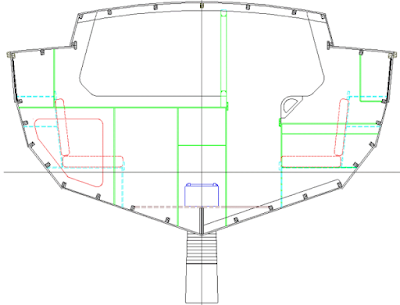I have added a few designs to our website https://dixdesign.com, some as designs that haven't been seen there before and others as new variations on existing designs.
The Cape Charles 32TC is a new variation on the original Cape Charles 32 design, which has the same deck configuration as the smaller sisters in our Cape design range for lapstrake plywood traditional cruisers. The Cape Charles 32TC has a trunk cabin deck, which is a more seaworthy configuration for open ocean use. The reason is that the trunk cabin gives secure footing when working on the weather deck in rough conditions, also placing handrails close at hand when working on the leeward deck. It also makes it easier to fit a folding dodger over the front of the cockpit than fitting a dodger onto a flush deck. Other aspects of the design remain unchanged.
 |
| Cape Charles 32 TC cross-section. |
The Didi 28 is a small cruiser with good performance, built using our radius chine plywood method. It was commissioned as a more spacious sister to the Didi 26 and kept the same basic accommodation layout. I have added a new accommodation layout to this design, designated Accommodation B, which is more suited to cruising for a couple or small family. It is a more conventional cruising layout, with forward V-berths, midship galley and dinette, with aft quarter berth and heads. It also gains cockpit access to the large lazarette, which can be isolated with watertight bulkheads for emergency flotation. The client who commissioned this variation also wanted a fixed keel to replace the lifting keel, so this has also been added to the drawings. The most often requested feature on the smaller Didi designs is a sugar scoop stern, so I have added that option to the drawings while working on them, adding approximately 450mm (18") to hull length and a small increase in top-end speed.
 |
| Didi 28 Accommodation B, a better cruising layout. |
The DH550 plywood catamarans have proven themselves with multiple crossings of the Atlantic and Pacific Oceans, including surviving an attack by orcas off Gibraltar with minimal damage. We also have a composite version of this design that has not been on our website until now. The Acquinus c57 is based on the DH550 but can be built from foam/glass or foam/carbon materials. Other changes are flatter side decks and the sterns extended by approximately 750mm (30") to take it to 57ft LOA. Detailing included on the drawings covers both cruising keel and daggerboard options.
 |
| Acquinus c57 profile. |
More than 20 years ago I drew a pair of advanced single rowing shells for Slade Rowing in South Africa. The boats proved to be very competitive but the company failed from lack of funding and damage sustained in transport to the main market in Europe. Since then various enquiries for wooden versions eventually resulted in my drawing basic detailing for amateurs or professionals to build from wood strip over formers. The Slade Rowing moulds were for Light and Heavy versions and recent additions, commissioned by two builders in Australia, have added a Medium version, as well as one targeted at a 72kg rower. They are now on our website as Vision Rowing Shells, with basic wood construction plans available for all 4 versions.
 |
| Vision Light Single rowing shell, one of four weight options. |